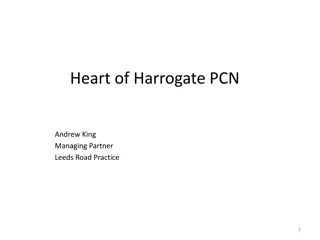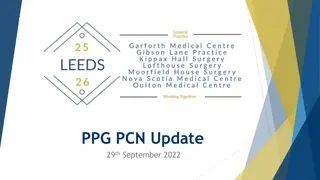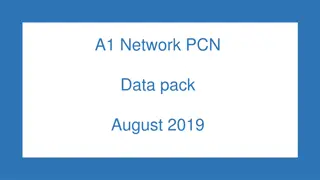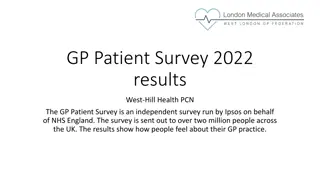Apache MINA: High-performance Network Applications Framework
Apache MINA is a robust framework for building high-performance network applications. With features like non-blocking I/O, event-driven architecture, and enhanced scalability, MINA provides a reliable platform for developing multipurpose infrastructure and networked applications. Its strengths lie i
3 views • 13 slides
Modeling and Generation of Realistic Network Activity Using Non-Negative Matrix Factorization
The GHOST project focuses on the challenges of modeling, analyzing, and generating patterns of network activity. By utilizing Non-Negative Matrix Factorization (NMF), realistic network activity patterns can be created and injected into live wireless networks. Understanding and predicting user behavi
4 views • 28 slides
Automated Anomaly Detection Tool for Network Performance Optimization
Anomaly Detection Tool (ADT) aims to automate the detection of network degradation in a mobile communications network, reducing the time and effort required significantly. By utilizing statistical and machine learning models, ADT can generate anomaly reports efficiently across a large circle network
8 views • 7 slides
Healthy Hyde PCN: Transforming Primary and Community Care for Integrated Services
Explore the success and evolution of Healthy Hyde PCN in integrating primary and community care reform, with a focus on patient-centric services, innovative programs, and initiatives to tackle health inequalities. Discover the structure, services, and efforts to put the patient at the center of care
1 views • 5 slides
Revolutionizing Network Management with Intent-Based Networking
Explore the concept and benefits of Intent-Based Networking (IBN) in simplifying network configuration and enhancing efficiency. Learn how IBN automates network operations, aligns with business objectives, improves security, and ensures scalability and reliability. Discover the potential of IBN tool
0 views • 14 slides
Understanding Primary Care Networks in Harrogate
Primary Care Networks (PCNs) play a crucial role in reshaping healthcare services in the NHS, focusing on out-of-hospital care and closer collaboration between different services. In Harrogate, the local Clinical Commissioning Group (CCG) has endorsed 4 PCNs covering the entire GP registered populat
0 views • 11 slides
Network Compression Techniques: Overview and Practical Issues
Various network compression techniques such as network pruning, knowledge distillation, and parameter quantization are discussed in this content. The importance of pruning redundant weights and neurons in over-parameterized networks is highlighted. Practical issues like weight pruning and neuron pru
0 views • 37 slides
Overview of Primary Care Network (PCN) Roles and Initiatives for Sustainable Healthcare Delivery
Primary Care Networks (PCNs) play a crucial role in healthcare by focusing on community health, managing long-term conditions, ensuring timely access to services, and promoting sustainability. Key PCN priorities include healthier communities, well-managed patient care, integrated working, and innova
0 views • 7 slides
Network Slicing with OAI 5G CN Workshop Overview
Overview of Network Slicing with OAI 5G CN workshop focusing on the crucial role of network slicing in realizing the service-oriented 5G vision. This workshop covers topics like multiple logical networks creation on shared infrastructure, different types of network slices, preparation and instantiat
1 views • 6 slides
Network Design Challenges and Solutions in Business Data Communications
Issues in designing a Local Area Network (LAN) include needs analysis, technological design, and cost assessment. The traditional approach involves structured systems analysis, but faces challenges due to rapidly changing technology and increasing network traffic. The Building Blocks Approach recomm
1 views • 20 slides
Port Authority of the Eastern Ligurian Sea - Citizen Initiatives and Goals
Learn about the key data and social initiatives of the Port Authority of the Eastern Ligurian Sea, including collaborations, activities, and goals for the PCN Meeting in Bilbao. Discover challenges and potential themes for future citizen activities in the port city.
0 views • 4 slides
Transforming Primary Care Networks for Improved Healthcare Collaboration
Thinking big about collaboration in primary care, key speakers highlighted strategies for enhancing outcomes, access, and workforce satisfaction. Modality, a leading GP super-partnership, is pioneering innovative models to serve over 1 million patients nationwide. Expectations are high for Primary C
0 views • 21 slides
Understanding 5G RAN Network Slicing and Architecture
Explore the intricate world of 5G Radio Access Network (RAN) and Network Slicing, delving into concepts such as SO Service Orchestrator, SDN-C Service Design, and Core Network Elements. Discover the significance of managing and designing mobile slice services, including eMBB, Massive IoT, and Missio
0 views • 26 slides
Understanding Snort: An Open-Source Network Intrusion Detection System
Snort is an open-source Network Intrusion Detection System (NIDS) developed by Cisco, capable of analyzing network packets to identify suspicious activities. It can function as a packet sniffer, packet logger, or a full-fledged intrusion prevention system. By monitoring and matching network activity
0 views • 23 slides
Data Flows and Network Challenges in Particle Physics Infrastructure
This overview delves into the data flows and network challenges faced in particle physics infrastructure, focusing on the JUNO project. It discusses the process of data reception, storage, and replication across various data centers, highlighting the bidirectional nature of data flows. Additionally,
0 views • 24 slides
Progress of Network Architecture Work in FG IMT-2020
In the Network Architecture Group led by Namseok Ko, significant progress has been made in defining the IMT-2020 architecture. The work has involved gap analysis, draft recommendations, and setting framework and requirements. Phase 1 focused on identifying 19 architectural gaps, such as demands for
1 views • 11 slides
Understanding Interconnection Networks Topology
Exploring the topology of interconnection networks helps determine the arrangement of channels and nodes, impacting network cost, performance, latency, energy consumption, and complexity of implementation. Abstract metrics such as degree, hop count, and network diameter play crucial roles in evaluat
1 views • 56 slides
Transportation Network Modeling and Analysis with C.Coupled SE Platform
This content outlines the features and functionalities of the C.Coupled SE Platform (CSET Platform) developed by the Connetics Transportation Group. It covers aspects such as interface design, inputs merging, purposes, platform development using Cube, TAZs merging, and network attributes. The platfo
0 views • 11 slides
Human Disease Symptom Network: Understanding Disease Relationships Through Symptoms and Genes
The Human Disease Symptom Network (HSDN) is constructed using a large-scale medical bibliographic records database to form a network of human diseases based on symptom similarities. By integrating disease-gene associations and protein-protein interaction data, correlations between symptom similarity
0 views • 37 slides
Introduction to Network Analysis Using .NET
This presentation introduces the concept of network analysis using .NET in the humanities classroom. It provides a template for teaching and adapting network analysis tools for educational purposes. The guide explains the relevance of networks in processing and visualizing data, emphasizing the coll
0 views • 20 slides
Care Coordinator Service Overview and Future Projects
Adele Bromley and Kasey-Lee Clarke are care coordinators at Leek and Biddulph PCN, providing personalized care plans and proxy ordering services in care homes. They work on various projects, such as health inequalities initiatives for patients with learning difficulties, menopause awareness, and upc
0 views • 5 slides
Support for General Practice Teams: Enhancing Health and Wellbeing
This initiative aims to increase health and wellbeing, build resilience, enhance team synergy, and improve self and team awareness in General Practice teams. It offers funding for team development, promotes reflection on personal and professional needs, and encourages setting shared goals. The fundi
0 views • 8 slides
Meridian: An SDN Platform for Cloud Network Services
Meridian is an SDN platform developed by Mohammad Banikazemi, David Olshefski, Anees Shaikh, John Tracey, and GuohuiWang at IBM T. J. Watson Research Center. The platform focuses on providing cloud network services efficiently. It encompasses an architecture that enables faster and more convenient n
0 views • 21 slides
Enhancing Network Security with Software-Defined Snort and OpenFlow
Explore the implementation of Snort, Barnyard, and PulledPork within a Software-Defined Network framework using OpenFlow technology. Learn how these tools enhance network security through intrusion detection engines, rule management, and network traffic control mechanisms. Dive into the architecture
0 views • 15 slides
Understanding Network Metrics Through Centrality Analysis
This presentation introduces network metrics as tools to describe network characteristics and answer important questions. Using centrality metrics as an example, participants learn how to identify the most important nodes in a network based on different criteria such as degree centrality and closene
0 views • 15 slides
Cassidy Medical Centre Patient Participation Group Meeting Details
The Cassidy Medical Centre Patient Participation Group discussed various topics in their meeting, including PCN updates, clinical triage, national GP patient survey results, staff roles, and administration team roles. Key points covered were Face-to-face PPG meeting, website updates, and staffing su
0 views • 9 slides
CPS Work Plan 2019/20: Engaging Contractors, Boosting Clinical Role, and Enhancing Community Pharmacy
The CPS Work Plan for 2019/20 focuses on engaging contractors, raising the profile of community pharmacy, enhancing the clinical role, and supporting new contracts and PCN engagement. Key challenges include engaging with stakeholders, implementing action plans, and identifying key opportunities for
0 views • 14 slides
Lister Medical Centre PPG Meeting Updates
The Patient Participation Group (PPG) at Lister Medical Centre is welcoming patients, carers, and GP practice staff to join and discuss various healthcare-related topics. The PPG aims to improve patient involvement, provide feedback on healthcare services, address patient complaints, and support hea
0 views • 9 slides
Enhancing Weight Management Services for Obese Patients in Melksham and Bradford-on-Avon PCN
Improve uptake of weight management services through a Digital Weight Management Programme (DWMP) targeting obese patients. Engage patients via text messages, referrals, and personalized interventions. Increase engagement with minimal cost and admin workload, leading to positive outcomes and minimal
0 views • 5 slides
Understanding Network Analysis: Whole Networks vs. Ego Networks
Explore the differences between Whole Networks and Ego Networks in social network analysis. Whole Networks provide comprehensive information about all nodes and links, enabling the computation of network-level statistics. On the other hand, Ego Networks focus on a sample of nodes, limiting the abili
0 views • 31 slides
Understanding Network Interference in CS590B/690B Lecture
Delve into the realm of network interference through the CS590B/690B lecture with Phillipa Gill at UMass Amherst. Explore topics such as Internet routing, timing attacks, BGP hijacks, Tor network functionality, relay selection, collusion scenarios, use of guards, web site fingerprinting attacks, tra
0 views • 11 slides
Demographic Profile of A1 Network PCN
A1 Network PCN has a total of almost 40,150 registered individuals, with a significant older population compared to other regions. The PCN shows a higher proportion of White British ethnic group and lower levels of relative deprivation. Birth rates, life expectancy, obesity rates, and overall health
0 views • 18 slides
West-Hill Health PCN GP Patient Survey 2022 Results Analysis
The GP Patient Survey 2022 results for West-Hill Health Primary Care Network (PCN) provide insights into patients' satisfaction levels with various GP practices. The survey covers aspects such as ease of access, helpfulness, satisfaction, and availability of appointment choices. Results show varying
0 views • 27 slides
Contribution of HALA Network to ATM Community and SESAR 2020: Achievements and Future Directions
HALA network has been instrumental in fostering research and innovation in the field of automation for ATM systems, providing a platform for knowledge dissemination, collaboration, and advancement. The network has facilitated exploratory research, encouraged young scientists' participation, and crea
0 views • 12 slides
Network Function Virtualization (NFV) Overview
Network Function Virtualization (NFV) focuses on virtualizing network functions to improve efficiency and reduce costs in network infrastructure. The lecture discusses key readings, devices that compose a network, specialization of devices, benefits of one-device-does-anything approach, and the goal
0 views • 21 slides
Enhancing Network Stability with Network Monitoring Systems
Network monitoring is crucial for efficient management and proactive issue detection in a network environment. Factors influencing an effective network system include choosing the best OEM, SLA agreements, and selecting a reliable System Integrator. Reactive monitoring can lead to financial losses a
0 views • 12 slides
Accelerating Systemic Change Network Inaugural Workshop Summary
The Accelerating Systemic Change Network held its inaugural workshop at Howard Hughes Medical Institute in July 2016 to address the lack of coordination in improving higher education. With a vision to become a professional hub for change researchers in STEM education, the network aims to enhance ind
0 views • 5 slides
University Network Section Overview July 2015 - March 2016
The presentation covers the network team structure, team members, objectives, goals, report outline, network statistics, accomplishments, and future plans of the university network section from July 2015 to March 2016. It highlights efforts to provide stable internet and intranet services, restructu
0 views • 16 slides
Understanding Vulnerable Populations in Holderness PCN
This data pack includes information on people whose circumstances may make them vulnerable within the Holderness Primary Care Network. The data is sourced from publicly accessible data held by various organizations including Public Health England, East Riding Yorkshire Council, NHS Digital, and othe
0 views • 10 slides
Demographic Data Analysis of Working-Age People in Holderness PCN
This analysis presents demographic data on working-age individuals, including those recently retired and students, within the Holderness Primary Care Network (PCN). The data covers various socio-economic factors such as income deprivation affecting children, households in fuel poverty, households in
0 views • 11 slides







































